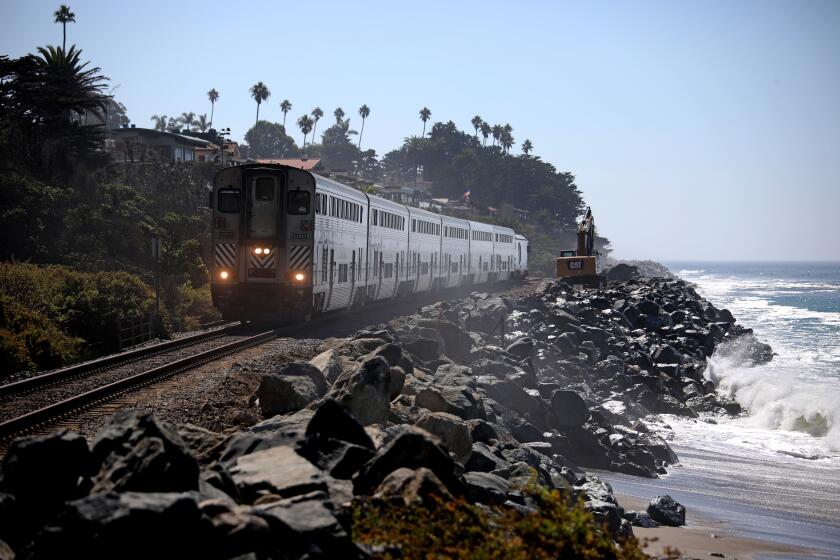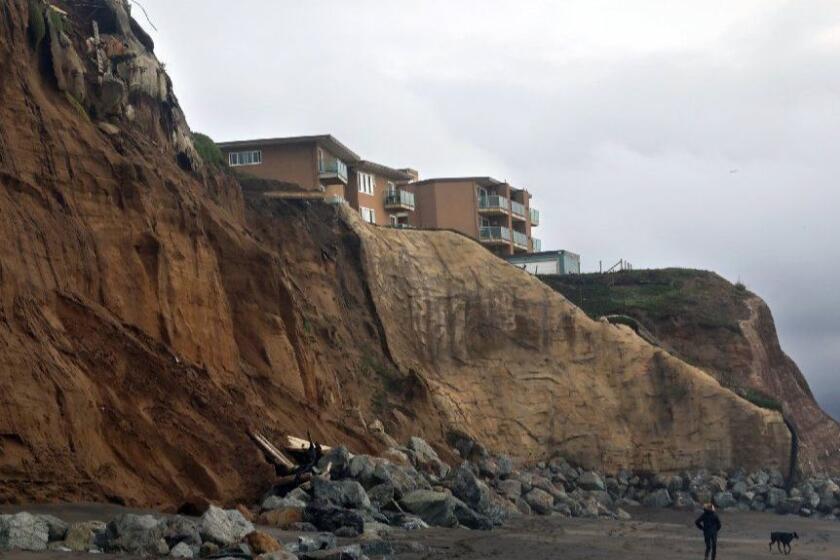Column: How I finally learned to care about Orange County’s crumbling coastline
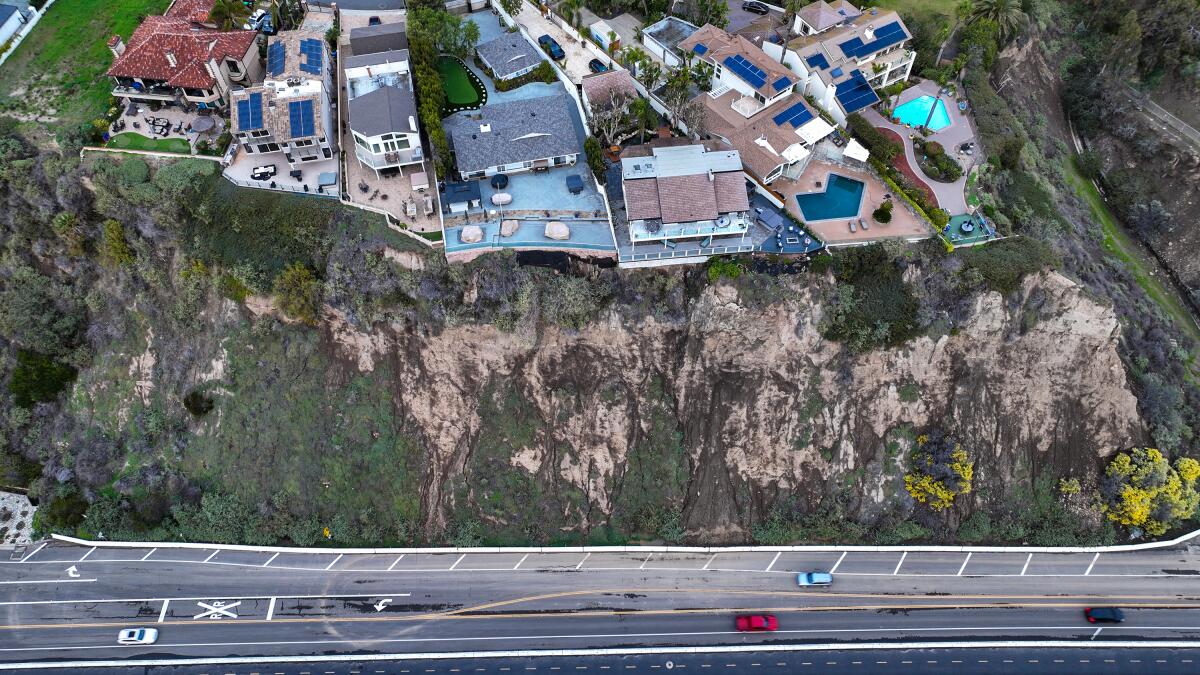
One Friday morning in October, I drove down Interstate 5 to a place I hadn’t been in years: San Clemente State Beach.
It‚Äôs at the southernmost tip of Orange County and not exactly O.C.‚Äôs prettiest shoreline ‚ÄĒ that would be Crystal Cove. But its campgrounds, ocean waves and trails have long made this stretch a favorite for residents and visitors alike.
Recently, transportation officials had shut down the train tracks that run just above the beach. A slow-moving landslide had shifted them more than two feet in just a year, and they were undergoing emergency repairs. Meanwhile, the Pacific Ocean kept creeping in closer and closer.
Metrolink had tried to protect the rail line from the sea the year before with 18,000 tons of riprap ‚ÄĒ large, jagged, ugly stones ‚ÄĒ dropped onto the beach side. The move, however, cut off access to the southern end of the beach at high tide and gave that section a post-apocalyptic look.
It was the latest casualty in the continuing erosion of south Orange County’s fabled coast.
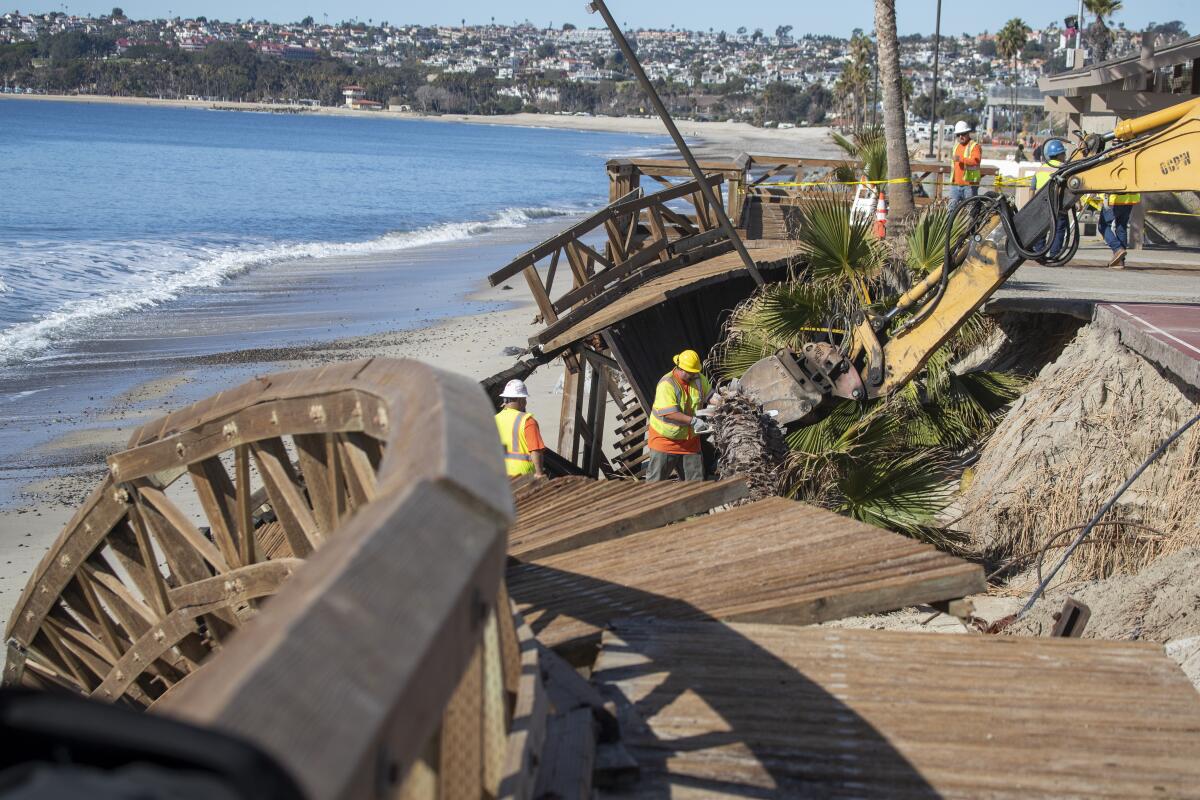
In the last decade, parking lots at Doheny State Beach in Dana Point have permanently shut down. In 2018, rising tides destroyed a boardwalk and a basketball court in Capistrano Beach that were once comfortably inland. That same year, Newport Beach added 9-inch concrete caps on a sea wall to keep quaint Balboa Island from becoming the next Atlantis.
The San Clemente trouble spot was about a mile away from the lot where I parked. I was walking toward the riprap piles when I noticed a wooden picnic table, sun-blasted but still sturdy. I sat down and took in the beauty of the beach to the north ‚ÄĒ and its foreboding future to the south.
Not even 10 minutes had passed before construction workers approached me. Could I move? Soon, a train hauling 24 gondolas and groaning with tons of riprap inched toward us. One by one, each rail car loudly dumped its cargo onto the sand, unleashing clouds of dust and mist.
I meant to write about what I saw, but the L.A. City Council racist tape scandal broke just a couple of days later. Since then, the problem at San Clemente State Beach has gotten only worse.
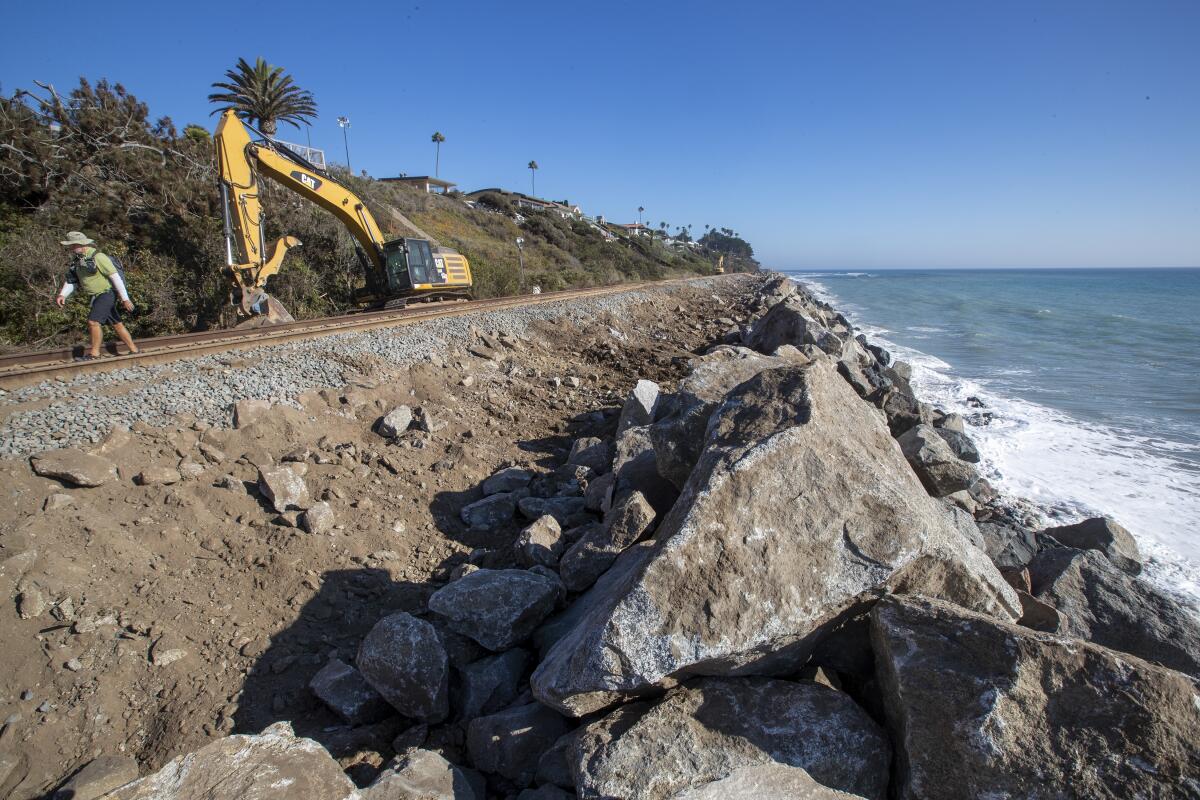
The winter’s heavy rains delayed fixes to the tracks. What was supposed to be a temporary shutdown for passenger trains extended all the way until the beginning of February, when weekend service started again for Amtrak’s Pacific Surfliner (Metrolink service still isn’t passing through). The Orange County Transportation Authority now expects all work to finish by the end of March.
I returned on Sunday, right after historic storms battered Southern California. Mother Nature has lashed out at Orange County all through this year.
Massive tides rushed through Bolsa Chica State Beach in Huntington Beach in January, tearing up an access road as though it was a noodle. Rainfall has engorged the Santa Ana River and its channels, a reminder of their destructive threat. The 5 Freeway North in Santa Ana just south of the Orange Crush shut down for hours on Saturday because a shallow pool had settled across all the lanes ‚ÄĒ a surreal scene I never imagined seeing there.
The atmosphere in San Clemente seemed more tranquil, at first. Surfers ran toward the waves. Middle-aged women power-walked on the trails. Three men with metal detectors and sifters swept through the sand.
The crowds thinned out the closer I got to the riprap, until I was the last person around. Before me were broken fire pits. Dead electrical wires snaked out of dirt mounds. A palm tree lay on boulders like a chewed-up toothpick. Small, pointy rocks littered the sand where there were none before. There was more riprap than ever.
The picnic table that once served as my temporary oasis was gone.
Officials with Metrolink are still responding to recent movement detected in the railway’s foundation near San Clemente after Tropical Storm Kay.
San Clemente had stayed on my mind throughout all these months, and not just because of the shutdown of the only train route between San Diego and Los Angeles. I wondered if it was time to feel sad for something I normally wouldn’t have much sympathy for.
For decades, coastal Orange County has seen itself as a world apart from those of us who live inland. It welcomes tourists from across the world to spend billions of dollars but looks warily on working-class Latinos from places like Anaheim and Santa Ana who just want a day out.
Even though I grew up about half an hour away from the coast, I can count on one hand the number of times I‚Äôve waded into the beach in Orange County. As a teen, stories of racist locals and unfriendly police officers kept me far away. As an adult, the politics of the coast ‚ÄĒ anti-immigrant and archconservative for decades, pro-pandejo during the COVID-19 era ‚ÄĒ don‚Äôt exactly motivate me to spend my money there.
South Orange County in particular represented O.C. at its most beautiful and foolish. Any time I passed through San Clemente and Capistrano Beach, I was reminded of the late Mike Davis‚Äô infamous essay ‚ÄúThe Case for Letting Malibu Burn.‚ÄĚ Why feel sorry for people who can afford to move away from the ravages of climate change and who have historically never cared about the issues affecting O.C.‚Äôs poorer cities?
I shook my head at multimillion-dollar homes perched on seaside cliffs or erected right on the shoreline. There’s a reason the Native Americans, Spaniards and Mexicans left this part of the coast largely untouched. In a battle between humans and the Pacific, the Pacific will always win.
But the missing picnic table near the riprap turned my schadenfreude into guilt. Even O.C. conservatives are actually pretty liberal when it comes to climate change. A 2021 survey by Chapman University researchers found that 79% of O.C. residents ‚ÄĒ including 58% of Republicans ‚ÄĒ thought climate change was a ‚Äúserious‚ÄĚ problem. Nevertheless, only six cities have adopted climate action plans ‚ÄĒ and three of them are beach towns: Huntington Beach, Laguna Beach and San Clemente.
Even as quakes, wildfires and drought have taken up most of our focus, the slow-moving disaster of rising seas has paralyzed Californians, and left us with ‚Äúboth too much and not enough time‚ÄĚ to act, as environment reporter Rosanna Xia wrote in a special report examining sea level rise and the future of California‚Äôs disappearing coastline.
A few days after my visit, I called up Buena Park Councilmember Jose Trinidad Castaneda, a Democrat who has long organized around climate change issues. He used to take the Metrolink from his hometown to San Clemente.
‚ÄúIf I wanted to take a day to rest and relax and feel like I‚Äôm getting away from O.C., a train ride and a hot dog on the pier was my classic getaway,‚ÄĚ he said.
But he hasn‚Äôt returned since the riprap came ‚ÄĒ ‚ÄúIt‚Äôs depressing to look at.‚ÄĚ
Castaneda understands why inlanders might not shed tears about what San Clemente and other O.C. coastal communities are weathering, and vice versa.
‚ÄúThere should be a want and a need for people to care, but I think the way Orange County is built with single-family tract homes, it‚Äôs what leads to the psychological disconnect,‚ÄĚ the council member said. ‚ÄúSo what can people do to make people realize it‚Äôs not just about them? It‚Äôs your neighbors, family, church members, co-workers.‚ÄĚ
He suggested that coastal residents go to inland Orange County during the peak of summer and ‚Äúwalk around all day‚ÄĚ to feel empathy.
For me, it was that picnic table.
On the walk back to my car, I noticed something perched on an embankment next to the tracks, just above my head and not too far away from the riprap. It was a group of picnic tables. One of them teetered over the embankment’s edge.
May it never fall.
More to Read
Sign up for Essential California
The most important California stories and recommendations in your inbox every morning.
You may occasionally receive promotional content from the Los Angeles Times.
